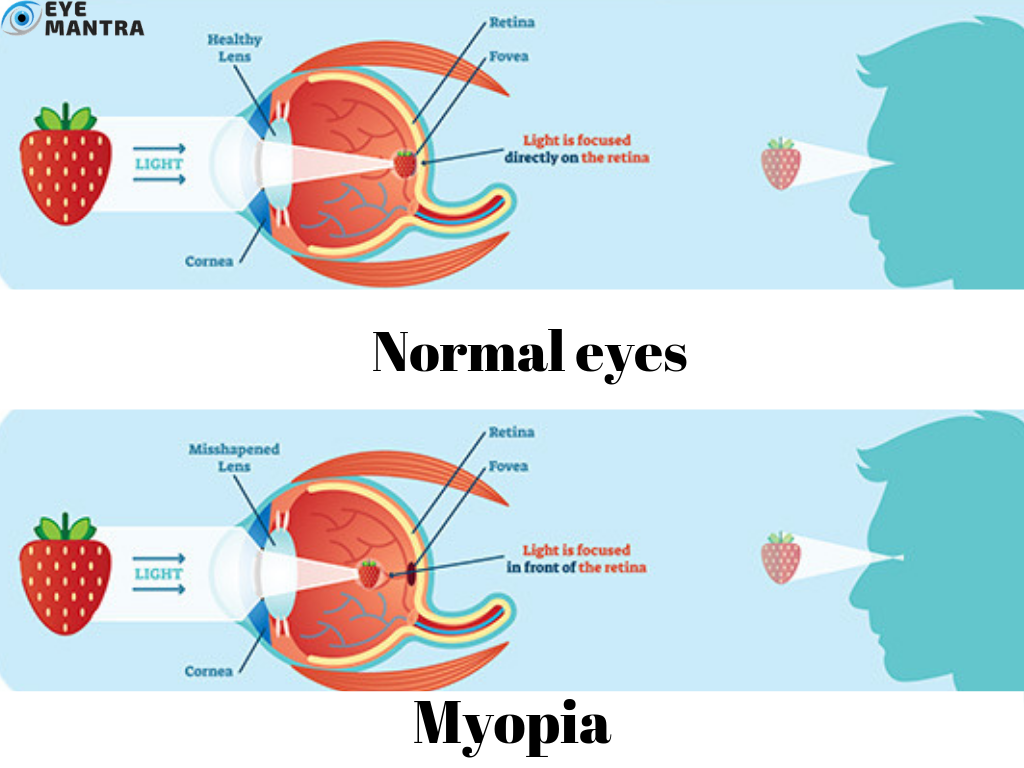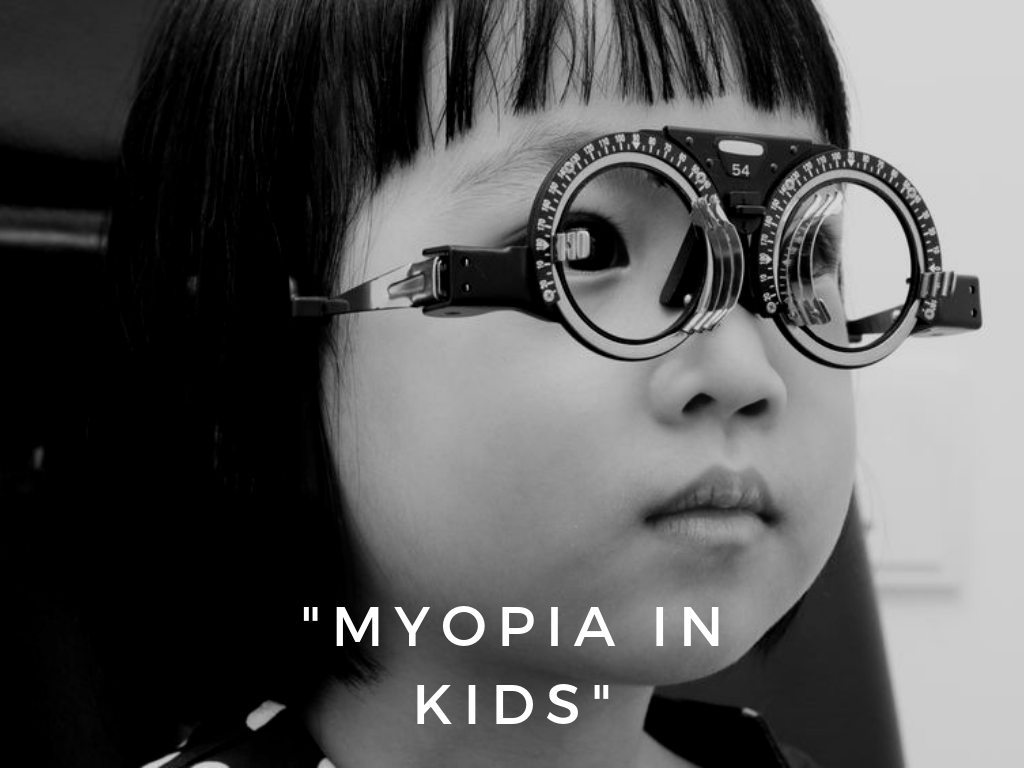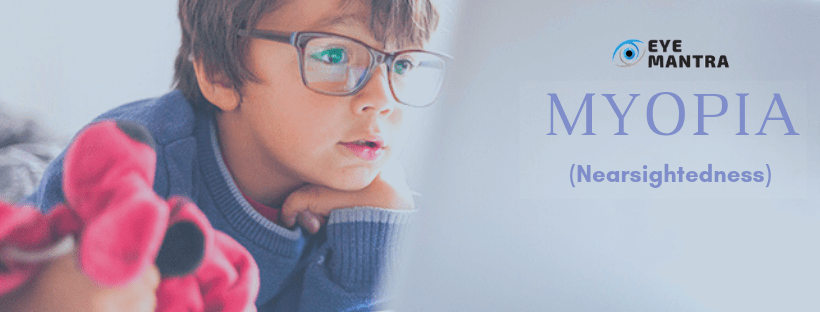Contents
About Myopia
Myopia is a common vision problem in which you cannot see far away objects clearly. They appear to be blurry but the person can view nearby objects. It happens when the shape of your eye makes light rays bend (refract) wrongly, focusing images in front of your retina rather than on your retina. This can happen at any age and it may develop slowly or rapidly.
Nearsightedness usually names Nearsightedness. It usually occurs at the age of 40. But nowadays usage of laptops, mobile phones give a larger impact on eye creating this problem. A basic eye exam can validate nearsightedness. You can pay for the blur with eyeglasses, contact lenses, or refractive surgery.
Symptoms of Myopia
Nearsightedness is usually first identified in childhood and is usually diagnosed in the early school years by teens. A child with nearsightedness may also have symptoms. Its symptoms may include:
- Blurry vision when seeing at faraway objects
- Eye strain and Headaches
- Require to sit closer to the television, movie screen, or the beginning seat of the classroom
- The requirement of squinting or partly close the eyelids to view precisely.
- The problem in viewing while driving a vehicle especially at night called night myopia
- Determined squint problem
- Blink more than required
- Rubbing of the eyes frequently
- Eye Fatigue
Causes of Myopia

- Nearsightedness happens when the eyeball is too large, relative to the focusing power of the cornea and lens of the eye. This creates light rays to focus at a point in front of the retina, rather than straight on its surface.
- It can also be caused by the cornea and lens being too rounded for the length of the eyeball. In a few cases, myopia happens due to a mixture of these factors.
- Myopia typically starts in adolescence, and you may have a greater risk if your parents are nearsighted. In most cases, nearsightedness processes in early adulthood but sometimes it remains to grow with age.
In addition to nearsightedness, other refractive errors add:
- Farsightedness (Hyperopia)
This happens when your eyeball is smaller than normal or your cornea is curved too small. The effect is the reverse of nearsightedness. In adults, both near and far objects are blurred.
This happens when your cornea or lens is bent more steeply in one direction than in other. Uncorrected astigmatism blurs vision.
- High Myopia
It’s a more severe form of the state, where the eyeball grows more than it is thought to and grows very long front to back. Also, making it hard to view things at a distance, it can increase your chance of having other diseases like a detached retina, cataracts, and glaucoma.
- Degenerative Myopia
It is a rare type you normally inherit from the genes of your parents. Your eyeball gets large very fast usually in the teenage or early adult years. Makes it hard to see things at a distance, you may have a greater chance of having a detached retina, abnormal blood vessel growth in the eye, and glaucoma.
Types of Myopia
There are 3 types of Myopia :
- Pathologic
It is caused by abnormal and excessive elongation of the axial height of the eye. It doesn’t grow before 6 years old.
- School-age
It happens within the age of 6-18 years. Stabilization is assumed by the late teens to early 20s.
- Linked with higher IQ scores
- More time spent reading
- Limited exposure to sunlight matched to non-myopic patients
- More prevalent in urban and industrialized countries
- Adult-onset
The early adult estimated age is 20 to 40 years and is affected by accommodative anomalies and near vision dominated occupations.
Risk Factors Associated With Myopia
Some risk factors may raise the possibility of increasing nearsightedness, such as:
- Genetics
Myopia induces from family genes. If one of your parents is myopic, your risk of acquiring the condition is raised. The risk is even huge if both parents are myopic.
- Reading and Computer Work
A person who does a lot of reading or works on computers is at grown risk of myopia. As we work for long hours in front of the computer and sometimes read books from too close. All these situations increase the chances of myopia.
Complications Under Myopia
Myopia is connected with various complications from medium to critical like:
- Reduced Quality of Life
Uncorrected myopia can affect your state of living life. You might not be ready to perform a task you wish for. And your poor vision may affect your day-to-day activities.
- Eyestrain
Untreated myopia can make you squint or strain your eyes to keep focus. This can start the problem of headaches and eyestrain.
- Impaired Safety
If you have an incorrect vision, then it means you and the other people both are at risk. For example, while driving a car you will not be able to see far away objects and an accident might happen. This a consequence of incorrect vision.
- Other Eye Problems
Severe myopia sets you at a somewhat increased chance of retinal detachment, glaucoma, cataracts, and myopic maculopathy. The tissues in large eyeballs are stretched and thinned which creates tears and bleed easily and scarring.
Diagnose Myopia- Regular Eye Exams
Since it may not always be readily obvious that you’re having a problem with your vision. The adults and teens have different examination procedures and even one can for online eye testing also. The following eye exam and eye testings should be performed:
Eye Exam For Adults
If you’re at huge risk of nearsightedness eye diseases get a dilated eye exam every 1 – 2 years in starting of 40 age.
If you don’t wear glasses or contact lens, have no signs of eye disease. Also, will at low risk of catching eye diseases like myopia-get an eye exam at the following intervals mentioned below.
- A first eye exam at age of 40
- In every 2-4 years between 40 – 54 age
- Every 1 to 3 years between 55- 64 age
- Even in every 1-2 years in the starting age 65
If you wear contact lenses or eyeglasses and also, may have any health problems like diabetes affect your eyes- in such cases, you should have regular eye checkups. Take advice from your doctor regarding your appointment schedules.
In case you find any problem with your vision contact the doctor immediately, even if you had an eye exam.
Eye Exam For Children And Adolescents
Children need to get eye scanned for recognizing eye disease by a paediatrician or ophthalmologist the eye doctor at the mentioned ages and time frames.
- At the age of 6 years – Monthly Checkups
- At the age of 3 years- Early Checkups
- Before first class and every 2 years during school times.
Treatment of Myopia

Myopia can be corrected with eyeglasses, contact lenses, or refractive surgery.
Eyeglasses
Eyeglasses are the initial choice of people for correcting the vision. Depending on the level of myopia, you must wear glasses for watching a movie or driving a car. Or, if you are extremely myopic, you must wear them all the time. Usually, a single-vision lens is directed to give clear vision at all distances. Though, patients over age 40, or children and adults whose myopia is because of the stress of near-vision work, may require a bifocal or progressive enlarging lens. These multifocal lenses provide different powers or strengths throughout the lens. Also, allow for sharp vision in the distance and close up.
Contact Lenses
For many people, contact lenses give a clearer vision and a broader field of view than eyeglasses. Though contact lenses are used directly on the eyes, they need complete care to safeguard eye health.
Orthokeratology
There is another option to treat myopia that is orthokeratology (ortho-k). It is corneal refractive therapy (CRT) and is a nonsurgical procedure. In this process, you wear a set of specially-designed rigid contact lenses to slowly reshape the curvature of your cornea. Further lenses put pressure on the cornea to flatten it. This improves the light entering the eye is centered. People with mild myopia may be capable to temporarily get a clear vision for most of their daily activities.
Laser Procedures
Laser procedures such as LASIK surgery or PRK are possible treatment choices for myopia in adults. A laser ray of light reshapes the cornea by eliminating a little amount of eye tissue. The amount of myopia that PRK or LASIK can correct is restricted by the amount of corneal tissue that can be carefully eliminated.
In PRK, a laser eliminates a tiny layer of tissue from the surface of the cornea to modify its shape and refocus light entering the eye.
LASIK surgery eliminates tissue from the internal layers, but not from the exterior of the cornea. To do this, an outer part of the corneal surface is lifted and closed back to show the inner tissue. A laser then eliminates the exact amount of corneal tissue required to reshape the eye. Then, the flap of the outside tissue is put back in place to improve.
Additional Refractive Surgery Procedures
People who are highly myopic or whose corneas are too thin for laser procedures must get myopia surgically corrected.
An optometrist will implant small lenses with the needed optical correction in their eyes. The implant can be set just in front of the natural lens or the implant can substitute the natural lens. This clear lens uprooting procedure is similar to cataract surgery but happens before a cataract is present.
Vision Therapy
Vision therapy is a choice for people whose blurred distance vision is created by a spasm of the muscles that regulate eye focusing. Many eye exercises can develop poor eye focusing ability and recover clear distance vision. Taking proper eye nutrition will also help in the elimination of myopia.
Phakic IOLs act like contact lenses, but they are surgically placed inside the eye and typically are permanent. Unlike IOLs applied in cataract surgery, phakic IOLs do not substitute the eye’s natural lens, which is left intact.
When To See A Doctor?
If you are facing a problem in viewing things far aways i.e seems blur from a distance and not able to perform tasks see visit the best eye hospital.
The doctor will decide the size of your myopia and recommend your choices to correct your vision.
Ask emergency medical care if you feel the below mention problems:
- The unexpected appearance of many floaters i.e. specks that appear to float by your field of vision
- Rays of light in one or both eyes
- A curtain-like shadow over your visual area
These are signs of retinal detachment, which is a rare complication of myopia. Retinal detachment is a medical emergency, and time is crucial.
Myopia or nearsightedness is a vision condition in which people can see near objects clearly, but things farther away seem blurred. It is the most common problem among people of all ages teens, adults, or aged. People with myopia can have a problem with seeing a movie or TV screen or the whiteboard in school. Myopia hits a notable section of the population, but this eye disorder is quickly corrected with eyeglasses, contact lenses, or surgery.
It is a refractive error. Refractive error is when the eye does not bend (refract) light correctly. The light does not adjust correctly so pictures are not clear. LASIK and other laser eye surgery procedures are valid long-term treatments for myopia.
Visit an ophthalmologist immediately if you experience any such symptoms or problems of Myopia. The excellent services are provided with full guidance. Do visit our website Eyemantra.
It is the best eye hospital in Delhi which offers various eye-related surgeries. We use all the latest technology to treat the eyes. Whether you are going through a cataract problem we offer Cataract Surgery treatment of the eyes. We also have services like Retina Surgery, Cataract Surgery, Specs Removal, and many more.
“Patient care is our first priority”
You can ring us at +91-9711115191 to book an appointment. Or email at eyemantra1@gmail.com.
You may also like:
Do’s and Dont’s for protecting your eyes while playing Holi
Eye injury : Causes and treatment
Convergence Exercises: Symptoms of Insufficiency & Treatment

